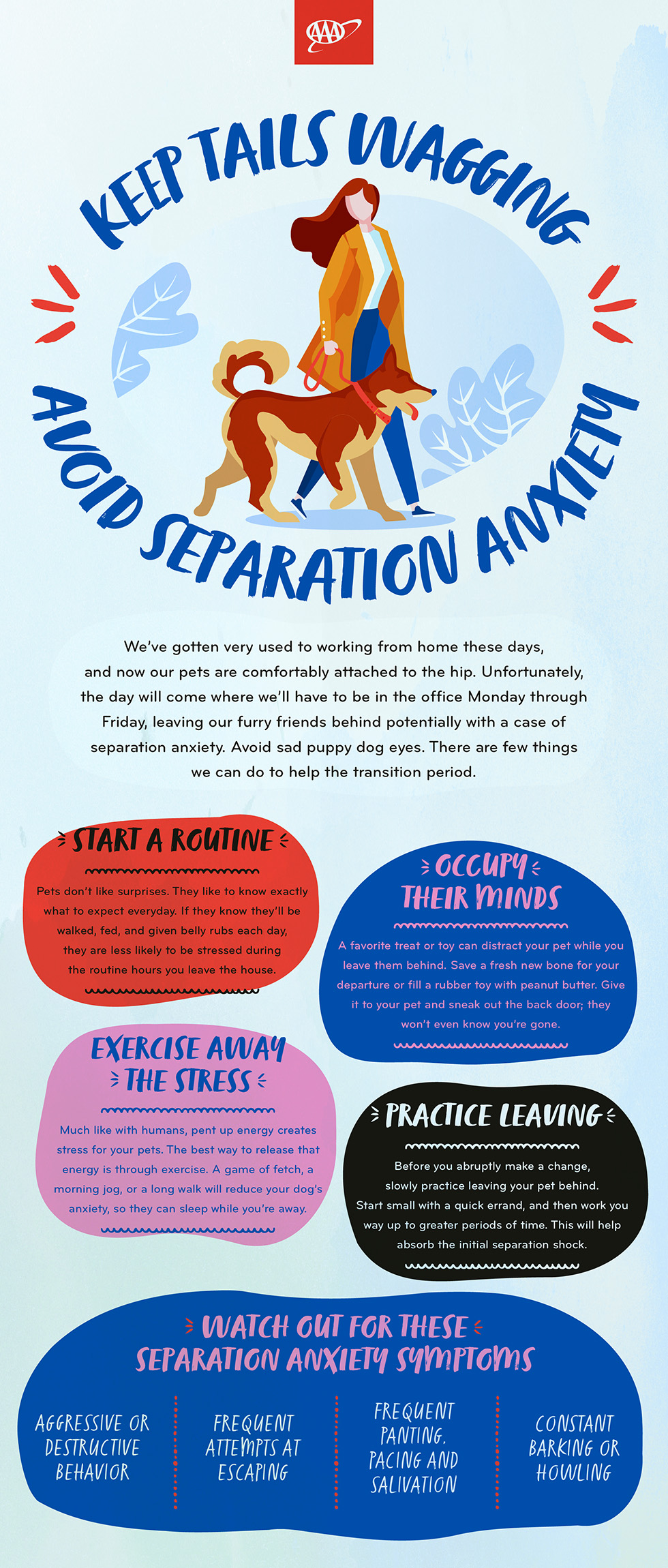


Humans aren’t the only ones navigating the COVID-19 pandemic. Family dogs have experienced a shift in their routines, too. Some are even seen as wins in the canine world: “My human is home more!”
However, what might have been a “win” for Fido at the onset of the pandemic is manifesting into a problem as adults and kids make the transition back to work and school, triggering in some pets a serious condition known as separation anxiety.
“When COVID first hit, nobody was contacting us,” says Malena DeMartini, a renowned dog trainer who specializes in separation anxiety and author of Treating Separation Anxiety in Dogs. “Then after about two months, as people starting thinking about going back to work or bringing home a new dog, we’ve seen a definite increase.”
This clinically diagnosable condition is exactly what it sounds like: Pets panic and become distressed when left alone. Signs might include vocalization (howling, whining, barking), destruction in the home, and urination or defecation. It affects 20 to 40 percent of dogs referred to animal behavior practices, according to a study from The Journal of the American Veterinary Medical Association.
DeMartini and Dr. Laurie Bergman, VMD, DACVB, a board-certified veterinary behaviorist, spoke with AAA on what to do if you suspect your dog has separation anxiety.
First, see your vet
Only your veterinarian can make a formal diagnosis—and potentially rule out any other medical conditions that might be inspiring behavior suggestive of separation anxiety. “I saw a dog for what the owner believed was separation anxiety,” says Dr. Bergman, “and it actually turned out to be an endocrine problem.”
Don’t wait
Start seeking out solutions as soon as you suspect a problem. “Those who wait, by the time they get in touch with me, the dog is much worse off,” says DeMartini. Also, even if your dog has learned to manage your absences in a healthy way, keep your pet’s coping skills fresh. “Take a walk without your dog to put those skills into practice,” says Dr. Bergman.
Record video of your dog’s behavior when left alone
Separation anxiety doesn’t manifest when you’re at home; it’s while you’re away. So capturing your dog on video while you’re out is extremely valuable, especially for vets and trainers, who can study body language, external stimuli, behavioral responses to your departure and arrival, etc.
It’s simple to do: Set up your computer, baby monitor, iPad, or some other recording device and then take short trips of about 20- to 30-minutes max, leaving behind a high-value treat for your pooch ahead of a departure. An immediate sign that anxiety may be at play, according to Dr. Bergman: “When dogs are anxious, they don’t eat.”
The complete video, however, should provide clues to what’s really going on, and the best ways to manage it. “You might see things on video that point not to separation anxiety,” says Dr. Bergman. “Instead, for instance, every time someone walks by, the dog redirects his aggression to the couch cushion.”

Behavior modification training is a must
An appropriate training plan and/or environmental reconfiguration can be formed based on video assessment and other considerations. Because anxiety inhibits learning, for both humans and dogs, any behavior training will focus on lowering that threshold for anxiety. This might begin with very quick trips to the mailbox and back, and building from there. “The goal is to teach the dog that when I walk out the door, nothing bad happens,” says DeMartini. Your vet, however, should guide you on the recommended course of action for your pet.
Consider hiring an expert
Working with a Board-certified Veterinary Behaviorist or a Certified Separation Anxiety Trainer (CSAT) can help to offset the stress that comes with training, and most offer help virtually. “The principals may be simple, but conducting the training can be complex,” says DeMartini. She offers a self-paced, online course called Mission Possible to support pet owners in this effort.
There is no one-size-fits-all solution
There likely will be some experimentation involved in helping your dog learn how to cope. “Every single dog that we work with is what we call a study of one,” says DeMartini of the customized training plans she creates for her clients. “It’s just like going to the psychologist, there is no cookie-cutter program.”
Ask your vet about prescription medication options
Vet-prescribed drugs such as Reconcile and Clomicalm are among the most commonly prescribed, but experts caution that these should be used in combination with behavior modification training, not as a stand-alone solution.

Use judgement when considering over-the-counter remedies
There are a lot of tools on the market that claim to help with pet separation anxiety, such as The Calmer Canine (a wearable device that utilizes micro-current signals), Calming Care (a probiotic supplement), and ADAPTIL (a collar that releases calming pheromones). CBD oil also has become popular among pet owners struggling with an anxious pet. As with anything, buyer beware. “My biggest concern is anything that keeps a dog owner from starting on a training plan eats up bandwidth—financial, emotional, and time bandwidth.” DeMartini says.
Crating is not a solution
What might seem like an “easy fix” could actually prove dangerous. “I’ve seen many dogs injure themselves trying to get out of crates,” says Dr. Bergman. “The adrenaline rush that happens when a mom lifts a car off a trapped toddler is the same thing that happens with dogs with anxiety.”
Do not punish your dog
“Dogs cannot make the connection to something they did three hours ago and the yelling and punishment being received when the owner gets home,” Dr. Bergman says.
Have patience
We live in a culture of instant gratification. However, that expectation needs to be put on hold when helping our furriest family member. “Dogs are on bio-speed not digital speed,” says DeMartini. “People who love their dogs, if they are willing to go the distance, they will see progress.” Just as you would for a human child, be patient with your furry one—and be prepared to put in the time to help them manage, if not overcome, their anxiety.
